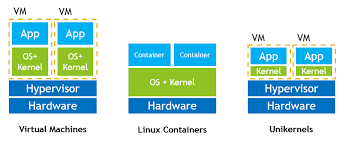
Cloud infrastructure is a crucial part of every growing business’s success. With the ability to store data online in a cloud, you can organize files, share information, and easily communicate with your clients and employees without physically sending important work documents through insecure pathways.
If businesses can somehow wrangle the power of applications without needing an external operating system, their efficiency, productivity, and security will all be increased simultaneously.
Let’s see how one such technology has emerged as a powerhouse in the tech industry.
What are unikernels?
A unikernels is an image that contains all data required to run an application in one package, without the need for an external hard drive, external software, or external operating system. With improved efficiency and organization, unikernels allow businesses to improve their security, scalability, and data protection.
How do unikernels work?
Although figuring out how unikernels work at first can seem confusing, it doesn’t have to be. Unikernels can be thought of as one machine image. Think of any image in your mind, and then think of that image containing all of the data and secure information from one place.
Unikernels are images that contain specific parts of the operating system needed to run an application. For example, think of Facebook. Unikernels are images that have all of the required information that is necessary to properly run Facebook without any glitches.
Unikernels have only one address space, meaning they work more effectively and securely when they only host a single process per kernel. Although unikernels can host various processes inside the image, having one unikernel per process is the safest and most straightforward.
What is the purpose of unikernels?
You may be wondering the importance of unikernels. After all, hundreds of cloud-based operating software systems are out there, so why are unikernels different?
More secure
Compared to other similar technology used for running applications and storing essential data processes, unikernels are safer and more secure. Since there is no external or internal operating system, this leaves fewer chances and fewer hackers’ spaces to get inside the system.
Before unikernels, Containers were the next big thing. However, Containers are not as secure when protecting against hackers since they need a conventional operating system to run applications. In this instance, Containers need to also use antivirus software to remain safe, whereas unikernels don’t need this extra application.
Higher performance
Along with being more secure against hackers, unikernels have improved performance compared to other options. When you don’t have an entire operating system, you can run more effectively by using hardware to solely focus on running your application instead of other aspects of an operating system.
Compared to other options, like Containers, unikernels are better in the performance comparison.
Quick start-up
Along with being better in performance standards, unikernels can start quicker than Containers or other technology. In less than one second, unikernels can boot up, compared to half a minute for Containers.
Independent – don’t need hardware to operate.
You can move a unikernel without being physically attached to external operating software or hardware.
Will unikernels replace Containers?
There is debate on whether unikernels will provide the same benefits that Containers do in the modern world. However, many proponents of this software state that unikernels can use the best Containers in security, speed, and performance.
On the other end of the spectrum, VMs are another choice for users. When comparing unikernels to VMs, they provide similar efficiency, portability, and security benefits.
Even with the possibly better performance and security, it is still a long shot that unikernels will replace Containers. Unikernels require more steps to create than Containers, requiring special software technology to build one unikernel. In addition, there is currently no solution for making unikernels in an automated fashion, making the building process time consuming and labour-intensive.
Since it takes longer to build and they are more complex, it will be unlikely that in the following years, unikernels will completely replace containers or VMs. However, once automatic production becomes possible, we could see unikernels replacing both technologies.
One scenario in which unikernels would dominate this industry is in a dynamic and ever-changing environment where applications constantly need to adapt to the changing speed. Since unikernels are more adaptable, using unikernels instead of Containers would let the user deploy applications quickly and fluctuate according to the different speeds.
Conclusion
Using unikernels to easily run an application without worrying about external software or cyber-attacks is the wave of the future. Combining the performance benefits of Containers and VMs, unikernels are a portable, efficient, secure, and performance-oriented option for providing a single image to run an application.
Although unikernels are not automatically produced currently, companies only have to wait a few years before they can benefit from this portable and hyper-secure option for their businesses.










